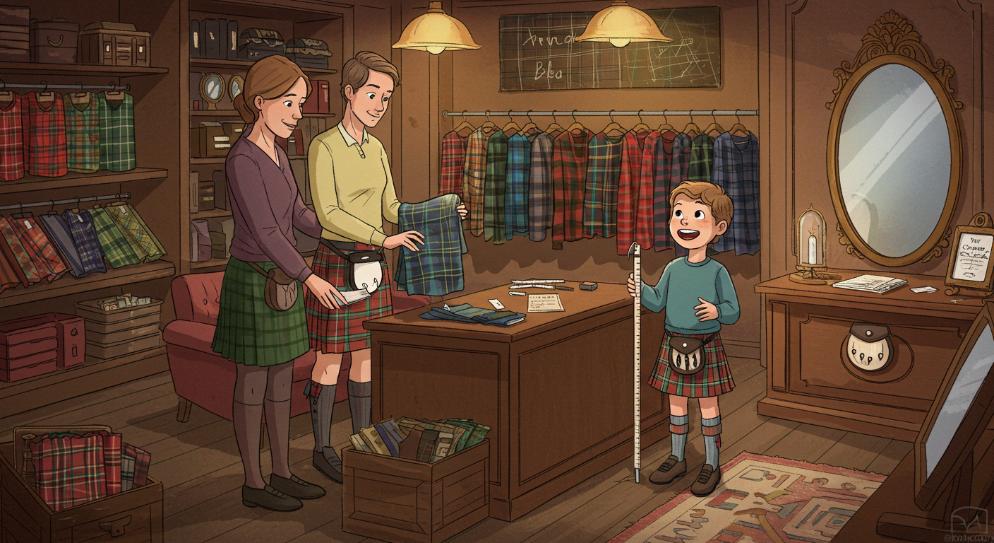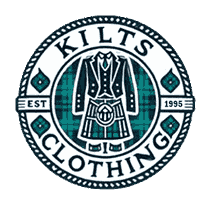How to Choose the Perfect Kilt for Your Child: A Parent’s Guide

Choosing the perfect kilt for your child can be an exciting yet slightly overwhelming task, especially with many styles, fabrics, and patterns. Whether for a special occasion like a wedding, a festive event like a Scottish celebration, or even just because your little one wants to wear something unique, a kilt is a versatile, stylish, and meaningful garment. But how do you make sure you're choosing the right one?
This parent's guide will help you navigate the process of selecting the ideal kilts for kids. From choosing the right size to picking the perfect tartan, we've covered you with simple steps to ensure your child's kilt is comfortable and fashionable.
1. Why Kilts Are Great for Kids
Before diving into the details of choosing the perfect kilt, it's essential to understand why a kilt is such a great option for your child.
Comfort and Freedom of Movement: Kilts allow your child to move freely, whether running around at a family event or playing outside. Youth kilts for sale made from breathable fabrics like wool or cotton, they keep kids cool in the summer and warm in the winter, depending on the material chosen.
Cultural and Fun: Kilts are also an excellent way for kids to learn about and connect with Scottish heritage or enjoy the fun and unique style. Whether honoring your Scottish roots or loving the aesthetic, a kilt is a great way to add some culture to your child's wardrobe.
Versatility: A kilt isn't just for special occasions. Depending on the style and fabric, people can wear it at family gatherings, school events, holidays, or even as part of casual everyday wear.
Now that we've covered why kilts are great, let's look at how to choose the best one for your little one.
2. Step 1: Choosing the Right Size
The right size is the first and most crucial step in choosing the perfect kilt. A too-tight or loose kilt can be uncomfortable and restrict your child's ability to move around.
Measuring Your Child: To find the correct size, you'll need to measure your child's waist, hips, and length. For the waist, measure around the natural waistline; for length, measure from the top of the waistband to the desired length (usually just above the knee). Many stores will have detailed size charts to help you choose the best fit based on these measurements.
Sizing Flexibility: Children grow fast, so consider sizing up if your child is between sizes. Many kilts come with adjustable waistbands or pleated designs that can accommodate some growth, ensuring the kilt fits longer.
Length Matters: The length of the kilt is another key factor. Traditionally, a kilt should reach just above the knee. However, you may opt for a slightly shorter kilt for ease of movement and comfort for younger children.
3. Step 2: Choosing the Fabric
Kilts come in various fabrics, and choosing the right one depends on the season, occasion, and your child's comfort.
Wool vs. Blended Fabrics: Traditional kilts are made from wool, perfect for colder weather and formal events. Wool is warm, durable, and carries the rich history of Scottish heritage. However, wool may be too warm for the summer or casual wear.
If your child will wear the kilt in warmer months or for casual occasions, consider kilts made from blended fabrics like cotton, polyester, or acrylic. These fabrics are lighter, breathable, and often more comfortable for everyday wear, making them an excellent option for school or casual outings.
Durability and Comfort: It's also important to consider the fabric's durability. Your child will likely be very active, so you'll want a fabric that holds up to wear and tear while still feeling comfortable against the skin. A soft lining can add extra comfort, especially for younger children.
4. Step 3: Picking the Right Tartan Pattern
One of the most exciting parts of choosing a kilt is picking the tartan pattern. The tartan adds a unique flair to the kilt and can represent important family or cultural connections.
Understanding Tartan: Tartan is a specific pattern of intersecting horizontal and vertical stripes, often in multiple colors. People sometimes link tartan patterns to Scottish clans or regions, with each clan having its distinct tartan. If your family has Scottish heritage, consider choosing a tartan representing your clan's history.
Choosing a Pattern for Your Child: You can select the tartan based on personal preference, the occasion, or family tradition. Kids often gravitate toward bright, colorful tartans, while people typically choose more subdued patterns for formal events. You can also let your child pick their favorite colors or patterns, especially if they're old enough to have a say in their wardrobe choices for personal kilts for kids sale.
Family Tartan: If your family has a Scottish background, choosing a kilt with your family's tartan is a meaningful way to celebrate your heritage. Many stores offer tartans representing different clans, so you can easily find the one that matches your family's history.
5. Step 4: Considering the Kilt's Occasion
Different occasions may call for various styles of kilts, and understanding when and where your child will wear the kilt is essential in making the right choice.
Special Events: For formal events like weddings, family gatherings, or cultural celebrations, a wool kilt with a traditional tartan is a great option. People usually wear these kilts with accessories like a kilt pin, sporran, and knee-high socks to achieve a polished look.
Casual Wear: If you're looking for a kilt that your child can wear for everyday activities, consider choosing a more straightforward, more casual style. Kilts from lighter fabrics like cotton blends are perfect for school events, parties, or casual outings.
Seasonal Considerations: People often wear kilts at festivals and outdoor events, so they should consider the season when choosing the fabric. Wool is ideal for colder weather, while lighter fabrics keep your child cool in the summer.
6. Step 5: Accessories to Complete the Look
A kilt isn't complete without the right accessories, and these finishing touches can elevate your child's outfit for any occasion.
Kilt Pins: A kilt pin is a small decorative brooch attached to the front of the kilt. While unnecessary, it adds a classic, stylish touch and can also help keep the pleats in place.
Sporran: The sporran is a small pouch worn at the front of the kilt. It's decorative and functional, allowing your child to carry small items like keys or coins.
Kilt Hose and Flashes: Knee-high socks, known as kilt hose, are a traditional part of the kilt ensemble. Flashes are garters that help hold the socks in place and add some style. For younger children, go for simple, soft socks that are comfortable and easy to put on.
Kilt Belt: A kilt belt adds an extra layer of polish to the outfit for more formal occasions. It's especially lovely when paired with a formal kilt for weddings or dances.
7. Step 6: Budget and Quality
Kilts come at various prices, and finding one that fits your budget and your child's needs is essential. While choosing the cheapest option is tempting, investing in a quality kilt will ensure it lasts through wear and tear. A well-made kilt can be passed down to younger siblings or even worn again for future occasions, making it a worthwhile investment.
8. Conclusion: Making the Right Choice for Your Child
Choosing the perfect kilt for your child doesn't have to be overwhelming. You can find a kilt that will make your child feel unique and stylish by focusing on size, fabric, tartan, occasion, and comfort. Whether for a wedding, a cultural celebration, or just because, the proper kilt will become a cherished part of their wardrobe.
So let your child express their personality with a kilt that suits their style and comfort. With these tips, you'll be ready to make the perfect choice!


